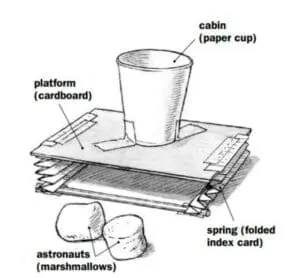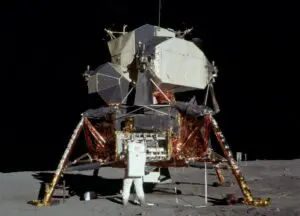Activity Content Sections
Instructions
Relevant Terminology
Shock absorber: A device used to dampen or lesson sudden, rapid motion.
Kinetic energy: Energy of motion. The cup of marshmallow astronauts is demonstrating kinetic energy when it drops.
Teams design, build, and test shock absorbers for a spacecraft lander to protect two marshmallow “astronauts”. They learn about the importance of shock dampening systems and about the Law of Conservation of Energy.

GETTING READY
Cut the cardboard into pieces approximately 4″ wide by 5″ long.
INTRODUCTION
How do you protect an astronaut from being crushed by the forces of lift-off?
NASA spacecraft require shock-absorbing devices. Rockets shake violently as they launch and landers touch down on places like the Moon or Mars with a great deal of force. Without shock absorbers, these extreme vibrations on launch would shake the astronauts with a force 5–6 times stronger than Earth’s gravity or destroy the delicate equipment in the landers when they reached these places in the solar system.
Introduce the design challenge by explaining that groups of 3–4 participants will design, build, and test shock absorbers for a spacecraft lander. The lander will consist of a platform (the cardboard) with shock absorbers underneath and a crew cockpit (paper cup) on top. Guidelines regarding materials for this activity:

One possible shock-absorbing system. Credit: Hannah Bonner for WGBH Educational Foundation
Participants can use any of the materials provided, and you may decide to limit the quantity of materials each person or group uses.
Provide guidance to participants if necessary:
Think about how you can use the materials provided to make springs or cushions. Build the shock absorbers on the bottom of the platform, and then attach a paper cup to the top of the platform. Test your design by placing two marshmallow astronauts, uncovered, in the cup and dropping it from a height of 1 foot. Adjust your design as needed.
Evaluate the success of each design.
ACTIVITY VARIATIONS
Design landers that will protect marshmallow astronauts from higher and higher drops.
Up the stakes by using an egg instead of marshmallows. Test prototypes with weights before dropping the egg.
Vary the materials provided.
TROUBLESHOOTING
If the device lands on its side, make sure it is being dropped straight. You may need to add a tail (like on a kite) to direct the fall so that it lands in the proper orientation.
If the lander bounces, try adjusting the springiness of the shock absorbers.
Shock absorber: A device used to dampen or lesson sudden, rapid motion.
Kinetic energy: Energy of motion. The cup of marshmallow astronauts is demonstrating kinetic energy when it drops.
QUESTIONS TO ASK AFTER THE ACTIVITY
QUESTIONS TO ASK AFTER THE ACTIVITY
Engineering Connections
Without shock absorbers, riding in a car would be both uncomfortable and dangerous! Not only do the shock absorbers create a comfortable ride by smoothing out bumps, but they also keep the tires on the road at all times. But shock absorbers aren’t used only in cars. They also protect buildings from earthquakes and make landing gear safer for airplanes and spacecraft.

Engineers working on the Apollo mission didn’t know whether the surface of the moon was hard or soft, so they had to prepare for both. Shock absorbers were built into the struts on the lander. Credit: NASA.
The first astronauts to land on the moon in the Apollo 11 spacecraft had no idea what landing there would feel like, since no one had ever done it before. This is a challenge engineers face: designing devices to do something that has never been done before, such as shock absorbers to protect a spacecraft that is landing on a new planet. The engineers for Apollo 11 had to understand math and science well enough to make a device that would protect the astronauts the first time it was used. Fortunately, everything went perfectly on the first moon landing!
Science Connections
The science of shock absorption becomes easier to understand if you think about eggs. If you were to drop an egg, what would be the best material to use as a shock absorber to keep it from breaking: wood, or Jell-O? The answer is clearly Jell-O. Jell-O has two advantages that make it a better choice. First, Jell-O has a high density (meaning it is thick and heavy), which allows it to slow the egg down quickly without getting pushed out of the way of the falling egg (like, say, a pile of feathers would). However, the second advantage is that its shape will change when the egg hits it. This means that the Jell-O pushes back against the falling egg. It slows it down over a longer period of time than it would if the egg hit a piece of wood. Since the Jell-O slows the egg down over more time (in other words, more gradually) than the wood does, the Jell-O makes it much less likely that the egg will break on impact.
Engineering Connections
In addition to using shock absorbers in cars, engineers have begun to use them in earthquake-resistant buildings. These are referred to as dampening systems. One dampening system found in earthquake-resistant buildings places dampers on each level of the building. The dampers are connected to a column. The dampers have a giant piston head inside of a cylinder filled with silicone oil. When the building begins to shake, the pistons push against and compress the oil, effectively converting the mechanical energy into heat energy, which eventually dissipates into the surrounding environment. After the 1989 Loma Prieta earthquake in San Francisco, engineers lifted City Hall from its foundation and rested it on 530 such dampers. If another earthquake hits, San Francisco City Hall can sway horizontally up to 26 inches before suffering any catastrophic damage to its structure.
Science Connections
According to the Law of Conservation of Energy, energy cannot be created or destroyed, only transformed from one type to another. Therefore, the only way to reduce the effects of kinetic energy, or energy of motion, is to transform that energy into another type of energy.
Shock absorbers are mechanical hydraulic devices. This means that they use pressurized liquids to transfer energy from one type to another. Shock absorbers dampen the effects of shock waves by converting the kinetic energy of the waves into heat energy that can be transferred into the hydraulic fluid. They are usually made of a cylinder containing a piston and springs that move up and down as a result of the vibrations caused by the shock. As the piston moves up and down, the hydraulic fluid is compressed and reduced, thereby transforming the “shocking” kinetic energy into thermal energy, which can be easily dissipated into the surrounding environment.
Join our community and receive activities, early access to programs, and other special news, and/or leave feedback on this activity below!
All of the content on this site is free!
Registering for the site helps us tailor future activities, webinars, and events so that we can serve you better.
Thank you for your interest and for helping us in our mission to transform lives as we put the E in STEM!
Leave feedback form
Thank you! Your submission is processing.